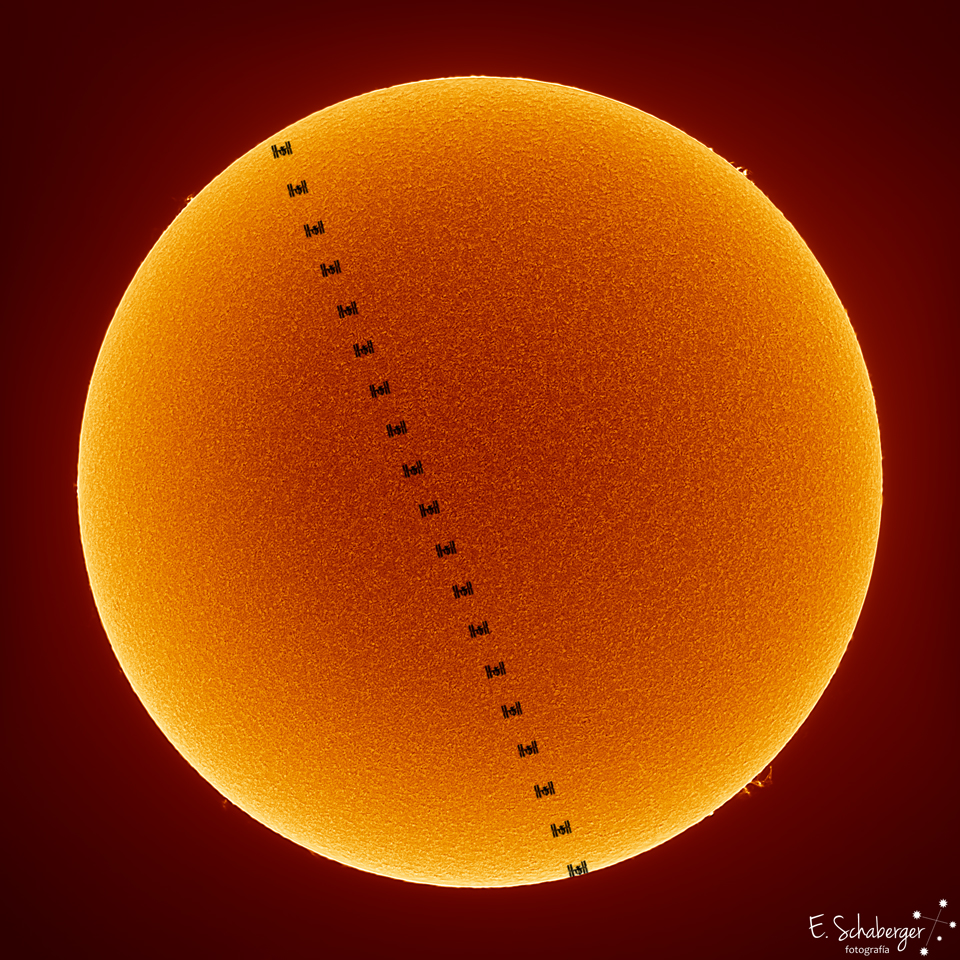国际空间站凌越无黑子的太阳
2019 October 28
The Space Station Crosses a Spotless Sun
Image Credit & Copyright: Eduardo Schaberger Poupeau
Explanation: Typically, the International Space Station is visible only at night. Slowly drifting across the night sky as it orbits the Earth, the International Space Station (ISS) can be seen as a bright spot about once a month from many locations. The ISS is then visible only just after sunset or just before sunrise because it shines by reflected sunlight — once the ISS enters the Earth’s shadow, it will drop out of sight. The only occasion when the ISS is visible during the day is when it passes right in front of the Sun. Then, it passes so quickly that only cameras taking short exposures can visually freeze the ISS’s silhouette onto the background Sun. The featured picture did exactly that — it is actually a series of images taken a month ago from Santa Fe, Argentina with perfect timing. This image series was later combined with a separate image highlighting the texture of the spotless Sun, and an image bringing up the Sun’s prominences around the edge. At an unusually low Solar Minimum, the Sun has gone without sunspots now for most of 2019.
国际空间站凌越无黑子的太阳
影像来源与版权:Eduardo Schaberger Poupeau
说明:通常,国际空间站仅在夜间可见。当国际空间站(ISS)环绕地球轨道运行时,它会在夜空中缓慢地移动,我们每个月都能从许多地方看到一次亮点。国际空间站仅在日落后或日出前才可见,因为它通过反射阳光而闪耀,一旦国际空间站进入地球的阴影,它就会消失不见。国际空间站在白天唯一可见的时刻是它正好经过太阳正前方时。然而,它经过的速度如此之快,以至于只有短曝光相机才能在视觉上将国际空间站的剪影定格在背景的太阳上。这幅精彩的影像确实做到了这一点,它实际上是由一个月前从阿根廷圣达菲拍摄的一系列照片结合而成,而拍摄时间恰到好处。这一系列影像后来与一张呈现了无黑子的太阳照片和一张呈现了太阳边缘日珥的照片相结合。在太阳活动异常少的极小期,太阳在2019年的大部分时间里都没有出现黑子。


1 条回复
[…] 说明: 太阳表面不停的在变。它有些年分很宁静,出现相对少量的太阳黑子和活跃区。而在其他的年分,太阳表面会剧烈翻腾,出现大量的太阳黑子,并经常发生日冕物质抛射和日闪(耀斑)。太阳表面因为对磁学性质的改变作出反应,每11年,会经历一次相对平静的太阳极小期及一次相对动荡的极大期。左侧主题影片所呈现的是2019年底的一个月,当时太阳处在极小期附近,右侧则是2014年的一个月,太阳处在极大期附近。这部影片是由美国航太总署的太阳动态观测卫星(SDO)摄于远紫外光波段。太阳正在向2025年的极大期迈进,不过即使是现在,太阳表面已出现令人惊讶的高活动量。 […]